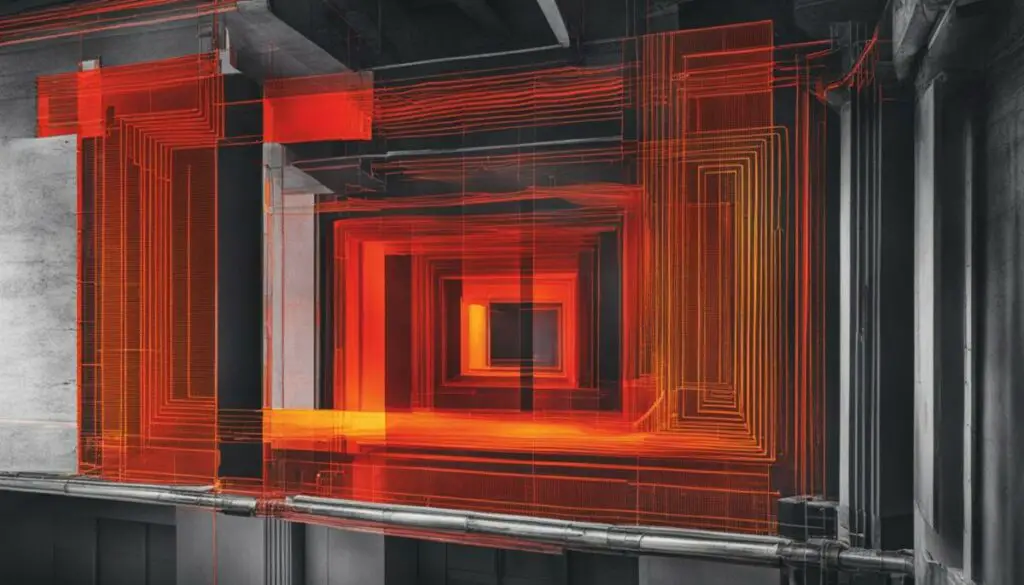Last Updated on 4 months by Francis
All material objects emit electromagnetic radiation, including infrared radiation. The amount and spectrum of radiation emitted depend on the object’s temperature. This phenomenon is known as blackbody radiation or thermal radiation. Blackbody radiation is constantly removing energy from objects, causing them to cool. However, objects also absorb infrared radiation emitted by other objects in their surroundings, maintaining a balance of energy exchange. Therefore, all objects have the capability to absorb infrared radiation, even at cooler temperatures where the radiation is mostly in the infrared region.
Contents
Key Takeaways:
- All objects have the capability to absorb infrared radiation, even at cooler temperatures.
- Infrared radiation is constantly emitted by all objects as blackbody radiation.
- Blackbody radiation plays a significant role in Earth’s climate and maintaining energy balance.
- Infrared radiation can be felt as heat and has practical applications in heating, sensing, and imaging.
- The absorption and emission of infrared radiation are crucial elements of the greenhouse effect.
The Role of Blackbody Radiation in Infrared Absorption

Blackbody radiation, also known as thermal radiation or heat radiation, is a phenomenon where all material objects emit electromagnetic radiation. The amount and spectrum of radiation emitted depend on the temperature of the object. As an object’s temperature increases, its emitted radiation transitions from reddish orange to white and eventually blue. Even at cooler temperatures, objects predominantly emit radiation in the infrared region of the electromagnetic spectrum.
This infrared radiation emitted by objects is of great significance and has various applications. For example, night vision equipment detects and converts this radiation into visible images, allowing for enhanced visibility in low-light conditions.
Furthermore, blackbody radiation plays a crucial role in Earth’s climate. The Sun, as the primary source of heat and light, emits blackbody radiation across a wide range of wavelengths. The Earth’s surface absorbs and radiates this heat energy, contributing to the temperature and climate system. Additionally, the Earth’s atmosphere also acts as a blackbody radiator, absorbing and emitting radiation that affects climate patterns.
Understanding the role of blackbody radiation in infrared absorption is essential for comprehending the complex interactions between objects and their surroundings.
Key Points:
- Blackbody radiation is the phenomenon of all material objects emitting electromagnetic radiation based on their temperature.
- As temperature increases, the spectrum of emitted radiation transitions from reddish orange to white and eventually blue.
- Objects predominantly emit radiation in the infrared region, even at cooler temperatures.
- Blackbody radiation has practical applications in night vision technology and plays a significant role in Earth’s climate system.
Examples of Objects that Emit Blackbody Radiation
Various objects emit blackbody radiation, including stars like the Sun, household heating and lighting systems, light bulbs, heat lamps, electric heaters, household radiators, electric stoves, flames, warm-blooded animals, night vision equipment, and sensors for automatic light switches and burglar alarms. These objects emit radiation due to their temperature and composition. The spectrum of an object’s blackbody radiation is determined by both its temperature and emissivity. While the examples mentioned here emit visible or infrared radiation, all objects emit some level of blackbody radiation.
Objects that emit blackbody radiation do so because of the thermal energy they possess. This energy causes the atoms and molecules within the objects to vibrate and move, resulting in the emission of electromagnetic radiation. The specific wavelengths and intensities of the emitted radiation depend on the temperature and material properties of the objects.
Varying temperatures and compositions result in different types of blackbody radiators. For instance, stars like the Sun emit a wide range of electromagnetic waves, including visible light and infrared radiation. Household heating systems, such as radiators and electric heaters, also emit infrared radiation as part of their thermal energy. Light bulbs and heat lamps produce visible light and infrared radiation to provide both illumination and warmth.
Warm-blooded animals, including humans, emit infrared radiation as a result of their body heat. Night vision equipment, which is used for surveillance and military purposes, relies on detecting the infrared radiation emitted by objects in the dark. Similarly, sensors used in automatic light switches and burglar alarms can detect changes in infrared radiation levels to determine the presence of individuals or objects in their vicinity.
| Examples | Radiation Types |
|---|---|
| Stars like the Sun | Visible light and infrared radiation |
| Household heating systems | Infrared radiation |
| Light bulbs and heat lamps | Visible light and infrared radiation |
| Electric heaters | Infrared radiation |
| Household radiators | Infrared radiation |
| Electric stoves | Infrared radiation |
| Flames | Visible light and infrared radiation |
| Warm-blooded animals | Infrared radiation |
| Night vision equipment | Infrared radiation |
| Sensors for automatic light switches and burglar alarms | Infrared radiation |
The Relationship Between Infrared Radiation and Heat

Infrared radiation, although invisible to the human eye, can be felt as heat. When infrared energy interacts with molecules in an object, it excites them and causes them to move faster, increasing the internal temperature of the object. While all wavelengths of radiant energy can heat surfaces that absorb them, infrared radiation is most commonly associated with everyday objects that emit it as radiant heat. Humans, for example, emit most of their radiant heat in the infrared range.
Around 50% of the Sun’s energy that reaches Earth is in the form of infrared radiation, playing a crucial role in maintaining a stable temperature and climate.
| Key Points: |
|---|
| Infrared radiation can be felt as heat. |
| Interaction of infrared energy with molecules excites them and increases the internal temperature of objects. |
| All objects emit some level of infrared radiation. |
| Humans emit most of their radiant heat in the infrared range. |
| Around 50% of the Sun’s energy to the Earth is in the form of infrared radiation. |
The Role of Infrared Radiation in the Greenhouse Effect

Infrared radiation plays a significant role in the greenhouse effect. Around 50% of the Sun’s energy that reaches Earth is in the form of infrared radiation. This radiation is key to maintaining Earth’s temperatures within a livable range.
“Infrared radiation is a crucial component of the greenhouse effect, allowing our planet to support life as we know it.”
One of the greenhouse gases that plays a vital role in the absorption and re-emission of infrared radiation is carbon dioxide (CO2). While gases like molecular oxygen and nitrogen do not possess this capability, carbon dioxide molecules are able to absorb and re-emit infrared radiation, trapping it in the atmosphere.
The absorption of infrared radiation by greenhouse gases, such as carbon dioxide, is what allows Earth to maintain a stable temperature by preventing too much heat from escaping into space. This process creates a natural insulation effect, similar to how a greenhouse keeps plants warm.
“The greenhouse effect keeps the Earth’s surface warm and habitable by inhibiting the loss of infrared radiation into space.”
However, it is important to note that human activities, particularly the burning of fossil fuels, have significantly increased the concentration of greenhouse gases in the atmosphere. This excess of greenhouse gases leads to an imbalance in the greenhouse effect, resulting in a phenomenon known as global warming.
“The increased presence of greenhouse gases, including carbon dioxide, in the atmosphere contributes to an enhanced greenhouse effect, leading to rising global temperatures and climate change.”
As a result, understanding the role of infrared radiation in the greenhouse effect is crucial in addressing climate change concerns and developing sustainable solutions for the future.
Image illustrating the interaction between infrared radiation and the greenhouse effect.
Practical Applications of Infrared Radiation

Infrared radiation has a wide range of practical uses across various industries and fields. Let’s explore some of the key applications where infrared radiation finds its valuable utility:
Infrared Heating
Infrared heating systems are employed in multiple settings, including residential, commercial, and industrial environments. With their efficient and focused heat distribution, these systems provide effective heating solutions for spaces of different sizes and requirements.
Here are some practical uses of infrared heating:
- Infrared heating panels for residential homes and offices, offering energy-saving and cost-effective heating options.
- Infrared saunas, providing therapeutic benefits through gentle and deep heat penetration into the body.
- Industrial processes such as drying, curing, and heating in manufacturing facilities.
Infrared radiation’s ability to transfer heat directly to objects and surfaces makes it an efficient and versatile heating technology.
Night Vision
“With the help of infrared radiation, night vision devices enable us to see what lies beyond the darkness, enhancing our safety and security.”
Night vision goggles and cameras utilize infrared radiation to detect and convert the invisible radiation emitted by objects into visible light, enabling enhanced vision in low-light or no-light conditions. These devices find practical applications in various fields:
- Military and defense operations, enabling soldiers and surveillance units to navigate and observe in the dark.
- Law enforcement, aiding in search and rescue missions, surveillance, and tactical operations.
- Wildlife observation and research, allowing scientists and conservationists to study nocturnal animals without disturbing their natural behavior.
By leveraging the power of infrared radiation, night vision technology extends our visual capabilities beyond the limitations of natural light.
Infrared Imaging
“Infrared imaging opens up a whole new world of insight and information through the visualization of infrared radiation.”
Infrared imaging involves capturing and analyzing the emitted or reflected infrared radiation from objects, enabling applications in various fields:
- Biology and medicine, facilitating non-invasive imaging techniques for diagnostics, pathology, and research.
- Mineralogy and geology, assisting in the identification and characterization of minerals and rock formations.
- Defense and security, enhancing situational awareness, target detection, and surveillance capabilities.
- Astronomy, allowing astronomers to observe celestial objects and phenomena that emit predominantly or solely in the infrared spectrum.
Through infrared imaging, scientists, professionals, and researchers gain valuable insights and unlock hidden information across diverse disciplines.
| Application | Industry/Field |
|---|---|
| Residential heating | Construction |
| Saunas | Wellness |
| Industrial processes | Manufacturing |
| Night vision devices | Military, law enforcement, wildlife |
| Infrared cameras | Biology, geology, defense, astronomy |
These practical applications demonstrate the flexibility and value of infrared radiation across various industries and scientific disciplines. Moving forward, continued research and innovation in infrared technology will likely uncover additional uses and advancements in this influential field.
Infrared Sensing and Spectroscopy

Infrared radiation, with its unique properties, is widely utilized for sensing and detection applications. Infrared sensors are capable of detecting and measuring the heat emitted as infrared radiation by various objects. This technology has found extensive use in night vision goggles, infrared cameras, and thermal imaging devices. By capturing and analyzing infrared radiation, these devices enable enhanced visibility and detection, even in low-light or obscured conditions.
Infrared spectroscopy is another important application that involves the measurement of the absorption and emission of specific wavelengths of infrared radiation by different substances. This technique has diverse uses in fields such as chemistry, biology, and materials science. Scientists and researchers harness the power of infrared spectroscopy to identify and analyze substances based on their unique infrared spectra.
By examining the way substances absorb and emit infrared radiation, valuable information about their composition and molecular structure can be obtained. Infrared spectroscopy enables the identification of specific chemicals, the analysis of complex mixtures, and the determination of the presence or absence of certain functional groups in organic compounds.
| Application | Examples |
|---|---|
| Chemical Analysis | Laboratory analysis of organic compounds, identification of unknown substances |
| Environmental Monitoring | Detection and measurement of pollutants, monitoring air quality |
| Pharmaceutical Analysis | Quality control of drugs, determination of drug purity and stability |
| Forensic Science | Identification of unknown substances at crime scenes, analysis of trace evidence |
Overall, infrared sensing and spectroscopy provide valuable tools for scientists, engineers, and researchers to explore and understand the world around us. Whether it’s the detection of heat signatures or the identification of substances through their unique infrared spectra, these applications showcase the remarkable capabilities of infrared radiation in various scientific disciplines.
Quote:
“Infrared sensing and spectroscopy have revolutionized how we study and analyze materials. By harnessing the power of infrared radiation, we can delve deeper into the molecular world, unlocking valuable insights and opening new avenues of scientific discovery.” – Dr. Jane Thompson, Infrared Spectroscopist
Infrared Astronomy and Observations
Infrared astronomy is a branch of astronomy that focuses on the detection and study of infrared radiation emitted by objects in the universe. The use of infrared observation allows astronomers to explore and analyze objects that are too cool to emit visible light. This opens up a whole new realm of exploration, revealing complex structures and phenomena in nebulas, galaxies, and the overall structure of the universe.
One of the advantages of observing in the infrared spectrum is that infrared radiation can penetrate gas and dust more easily compared to visible light. This allows astronomers to observe objects that would otherwise be obscured in visible light, providing valuable insights into the nature of these objects and their surrounding environments.
The field of infrared astronomy has led to numerous important discoveries. For instance, infrared observations have enabled scientists to detect and study comets, asteroids, and interstellar dust clouds. These observations have provided valuable information about the composition, dynamics, and evolution of these celestial bodies.
Specialized CCD detectors that are sensitive to infrared photons are used in infrared astronomical observations. These detectors capture and convert the incoming infrared radiation into digital signals that can be processed and analyzed. This technology has greatly advanced our understanding of the universe and has allowed astronomers to gather critical data for further research.
“Infrared astronomy has revolutionized our understanding of the cosmos, allowing us to see beyond what the human eye can perceive. It has opened up a whole new world of exploration and has provided us with invaluable insights into the mysteries of the universe.”
To further appreciate the significance of infrared astronomy, the following table summarizes some notable discoveries made possible by the detection and observation of infrared radiation in space:
| Discovery | Significance |
|---|---|
| Identification of interstellar clouds and star-forming regions | Advancement in the understanding of star formation and the lifecycle of stars |
| Mapping of the cosmic microwave background radiation | Confirmation of the Big Bang theory and insights into the early universe |
| Observation of distant galaxies and quasars | Insights into the evolution of galaxies and the supermassive black holes at their centers |
| Detection of exoplanets | Expansion of our knowledge about planetary systems beyond our own |
| Exploration of the dusty regions in the Milky Way and other galaxies | Understanding the role of dust in the formation and evolution of galaxies |
In conclusion, infrared astronomy plays a crucial role in our exploration and understanding of the universe. The detection and observation of infrared radiation in space allow us to study objects that are otherwise invisible to us and provide valuable insights into their properties and behavior. With continued advancements in technology and instrumentation, infrared astronomy will undoubtedly continue to unravel the secrets of the cosmos.
Conclusion
In conclusion, infrared radiation absorption is a fundamental phenomenon observed in all objects with a temperature above absolute zero. Whether it’s the Sun, household objects, or even our own bodies, everything emits some level of infrared radiation. Although invisible to the human eye, we can feel infrared radiation as heat.
Furthermore, the absorption and emission of infrared radiation have significant implications in various fields. Infrared radiation plays a crucial role in Earth’s climate through the greenhouse effect, where certain gases absorb and re-emit infrared radiation, helping to maintain a stable temperature. Additionally, infrared radiation finds practical applications in heating, sensing, imaging, and astronomy.
Understanding the capabilities of objects to absorb and emit infrared radiation allows scientists to explore its potential applications. From infrared heating systems and night vision technology to infrared spectroscopy and astronomical observations, the study of infrared radiation unlocks new insights into our world and the universe beyond.
FAQ
Do all objects absorb infrared radiation?
Yes, all objects have the capability to absorb infrared radiation.
What is blackbody radiation?
Blackbody radiation is the phenomenon where all material objects emit electromagnetic radiation, including infrared radiation.
Can you provide examples of objects that emit blackbody radiation?
Sure! Examples include stars like the Sun, household heating and lighting systems, light bulbs, heat lamps, electric heaters, household radiators, electric stoves, flames, warm-blooded animals, night vision equipment, and sensors for automatic light switches and burglar alarms.
How does infrared radiation relate to heat?
Infrared radiation, although invisible to the human eye, can be felt as heat. When infrared energy interacts with molecules in an object, it excites them and causes them to move faster, increasing the internal temperature of the object.
What is the role of infrared radiation in the greenhouse effect?
Infrared radiation plays a significant role in the greenhouse effect. Around 50% of the Sun’s energy that reaches Earth is in the form of infrared radiation. Carbon dioxide in the atmosphere can absorb, re-emit, and trap infrared radiation, helping to maintain a livable temperature on Earth.
How is infrared radiation used in practical applications?
Infrared radiation is used for heating purposes, night vision technology, imaging, and various sensing and detection applications in fields such as biology, chemistry, and astronomy.
What is infrared spectroscopy used for?
Infrared spectroscopy involves the measurement of the absorption and emission of specific wavelengths of infrared radiation by substances. It is utilized in various fields for substance analysis and identification.
How is infrared radiation used in astronomy?
Infrared astronomy involves the detection and study of infrared radiation emitted by objects in the universe. It allows astronomers to observe and analyze objects that are too cool to emit visible light, revealing hidden structures and objects in space.
In conclusion, what is the capability of objects to absorb infrared radiation?
All objects with a temperature above absolute zero emit some level of infrared radiation and have the ability to absorb infrared radiation.








